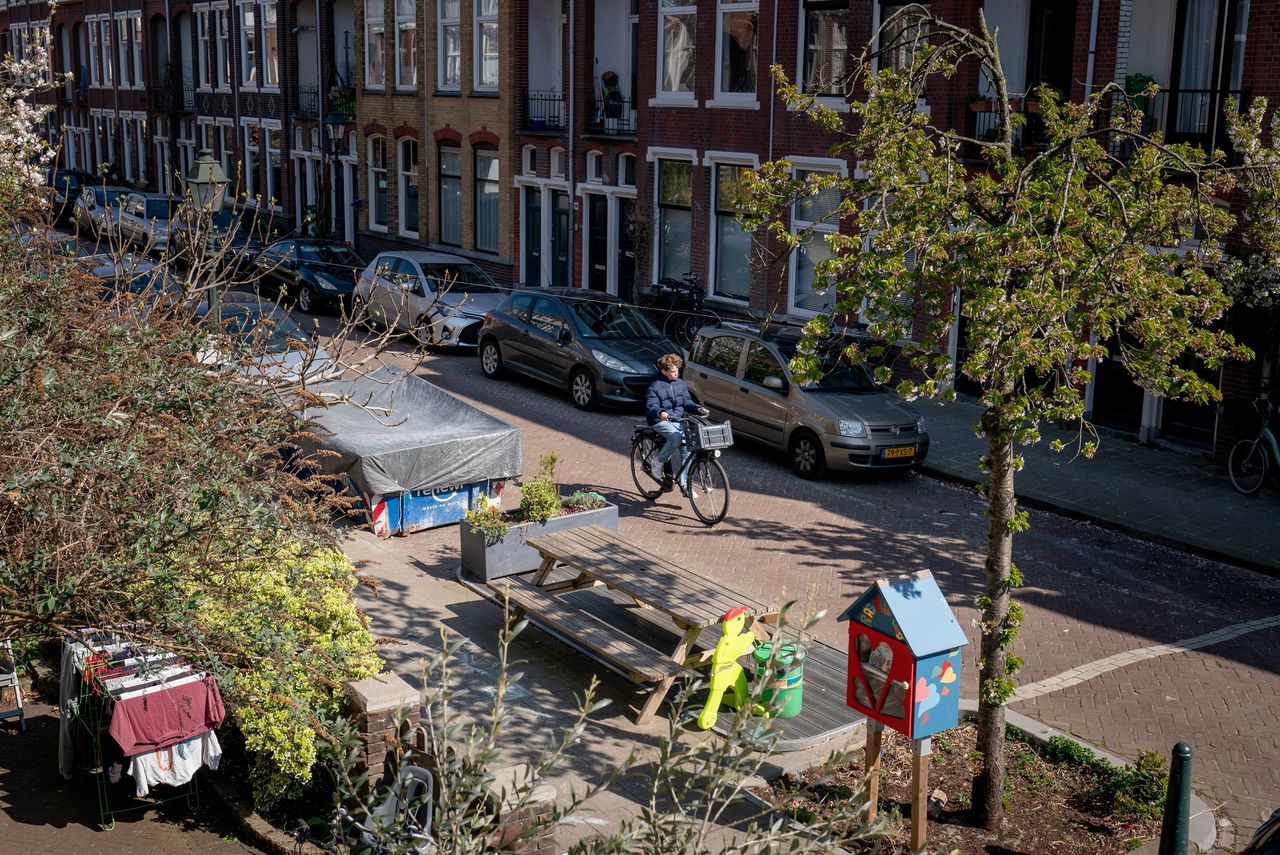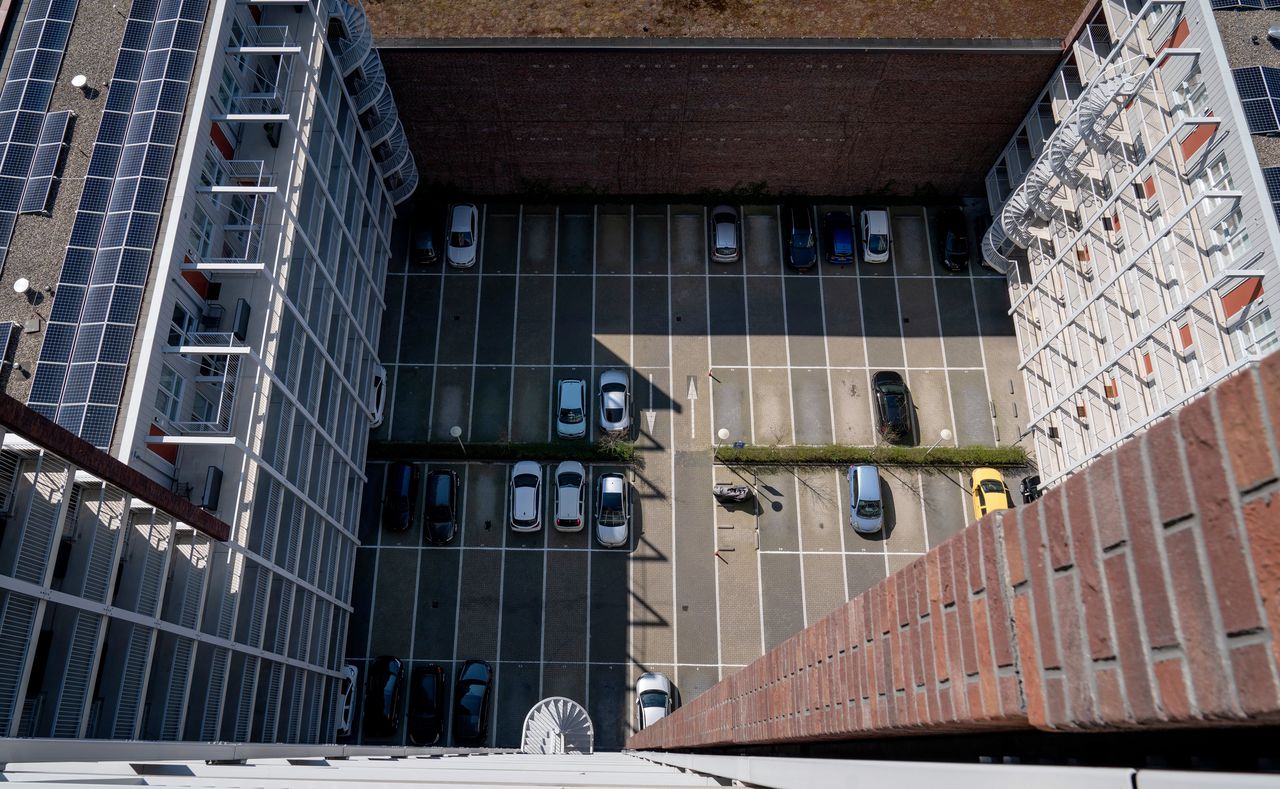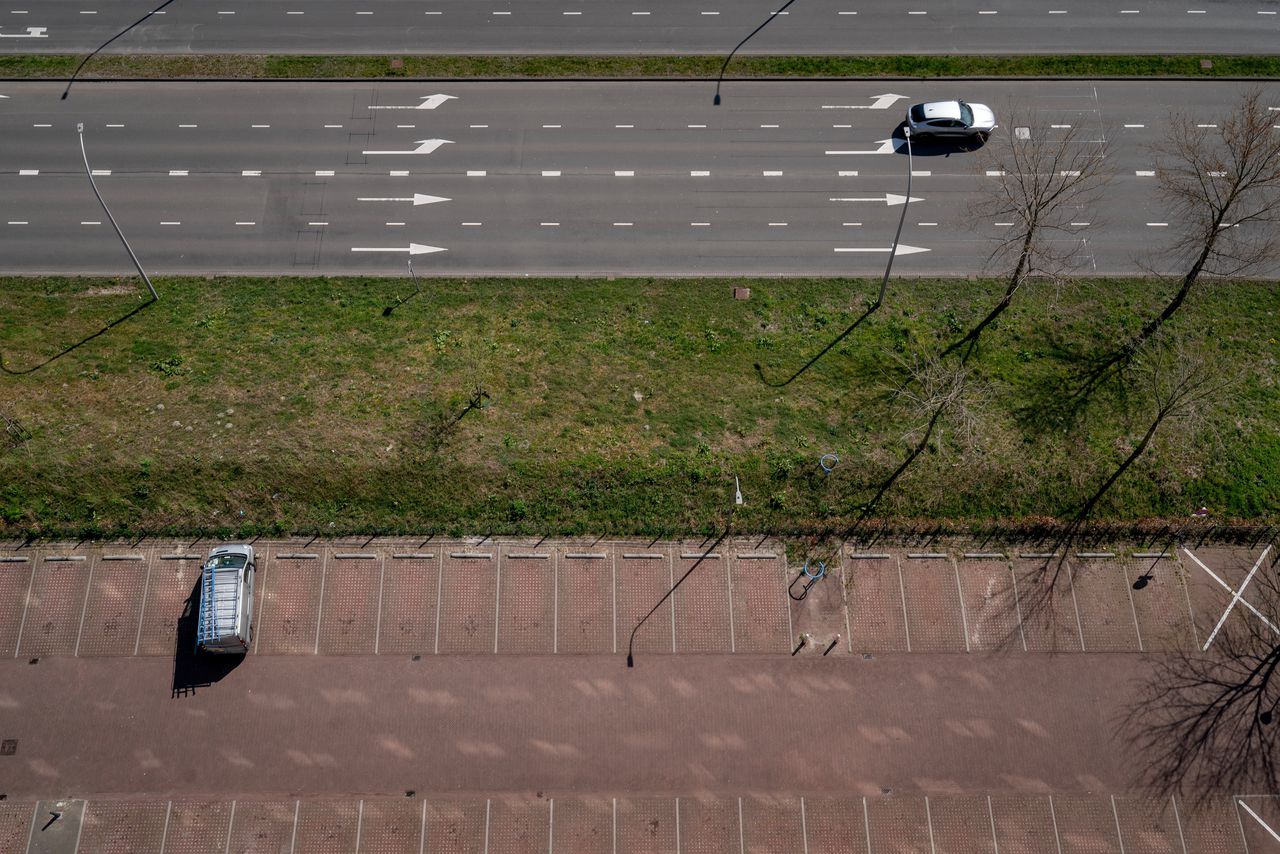De Hagenaar wants more space, but not at the expense of the car. (Certainly not the one car)

An ordinary afternoon, by dinner. A procession of cars slowly moves into The Hague, about the last part of the A12. Conversion at the traffic light for the provincial government office. Fixed traffic on the Vaillantlaan in the Schilderswijk, at the intersection near the Uithof in the south of the city.
In the morning just after eight: loading and unloading trucks, delivery vans in the Goudenregenstraat, in the Frederik Hendriklaan. School cyclists slalom around it. Hobbemaplein on a Wednesday market day, a jumble of pedestrians with shopping carts, cyclists, trams and cars. On Saturday it is much busier.
And always, in almost all districts of The Hague: motorists who ride laps, searching for a scarce parking space.
Every city looks for a balance between car, space and liveability. In Amsterdam A speed limit of 30 kilometers per hour was introduced and experimented by closing traffic arteries a year and a half ago. In Paris streets are made car -free, in London An emission zone applies to polluting vehicles.
In The Hague, city authorities have been trying to get De Hagenaar on the bike, in public transport or the shared car for ten years. There were fast bike routes, cycling courses, cheap bikes for children, parking facilities in vacant stores. Sneak traffic was discouraged, a circulation route started to send traffic flows, streets were car -free, parking permits limited to the third car, parking spaces used for partial scooters.
But The Hague is still the city with the highest car density per square kilometer and with the most inhabitants per square kilometer of the Netherlands. The number of cars per household – 0.6 – hardly decreased in ten years, while the number of inhabitants grew from 508,950 to 568,419.
And the population will also rise until 2040. « It will no longer fit, » says Alderman Arjen Kapteijns (Mobility, GroenLinks). He calculates that one hundred thousand inhabitants, fifty thousand jobs and 20 percent more ‘movements’. The city cannot expand in area, because she is stuck between coast and neighboring municipalities.
The Hague must choose: who gets which space?
The stationary car
In the Fultonstraat in the Valkenboskwartier there is a picnic table in a parking space, with a colorful minibieb next to it. Children play games, adults drink coffee or wine. The stately pre -war houses were divided into several apartments. Also in this neighborhood you have to ride laps if you want to park.
« We brutally put down a table. We didn’t have a car, but they did have small children. Why was there no space in the street? » Says Eline Keus. Over neighbor Estelle Smits: « The table ensures that we are a village in the city. We know each other here. »
When the municipality wanted the picnic table, some of the residents revolted. Elsewhere in the neighborhood there were already ‘bicycle floors’ – parking spaces that are exchanged for bicycle niets – and ‘terrace floors’ for cafés: why not a ‘Bankvlonder’? More than 73 percent of the street residents agreed to keep the table.
In exchange for the place they occupy, a number of inhabitants share a car; In this piece of neighborhood it concerns 102 families for 15 cars. « Most cars stand still for a large part of the time. You don’t buy a plane for once a year, » Rescher, who set up a residents’ cooperative.
Such a shared car or public transport, that is simply not realistic for hard -working people
Not all residents of the Fultonstraat are happy. « There are people who need a car, we are being bullied here, » says one of them. She doesn’t want to be in name NRCthere has been enough ‘hassle’ between neighbors about parking. She says: « Eight months a year is the cunt weather, then there is no one at that table. »
The picnic bench is not her only irritation. « I really don’t have to be at the door, but as a municipality, I use the scarce space economically. » She points to other parking spaces that were exchanged for bicycle niets or charging stations, for underground waste containers. There are shared cars in front of a warehouse where apartments were built.
The new car
That is the policy of the municipality: when new homes are being built, the project developer must make parking on site or point out residents to shared cars and public transport.
In the Boomblauwtjelaan in the Ypenburg district, at the social housing apartment that was portrayed four years ago, that seemed arranged. The courtyard was not a garden, but a parking space. Jennifer Romijn was one of the first inhabitants: « There was a full-is-full policy. If you couldn’t park, you drove back into the street. »

There were only 62 places for more than a hundred residents. That seemed no problem, to the municipality paid parking in this part of the neighborhood, as it was already decided in the development of the flat in 2017, also because of the proximity of a swimming pool and cinema. And the flat residents are not a parking permit for the street.
They are furious in the flat. According to them, the parking lot next to the flat is almost always empty. In the streets behind the flat, with owner -occupied houses that partly have their own parking space, the residents – as neighbor Michelle van der Lubbe expresses it – have « polish, two or three cars and a permit for the street ».
The housing corporation Lotse went into the flat. Romijn: « I felt, there are people who don’t have a car. » A solution was found by the municipality in the parking lot of the swimming pool next to the flat, but she says: « That is not that far, but still … »
Van der Lubbe agrees: « I have a daughter of eight months, I am there. » She is a nurse and works irregular hours. « Such a shared car or public transport, that is simply not realistic for hard -working people. »
Isn’t that green, that bed? Just make it parking spaces
The same say the residents of the starter houses on the other side of the swimming pool. They are also fed up with paid parking, for the first car you pay 97 euros per year, for the second 339 euros. A train station is fifteen minutes walk, the tram on five. « Public transport cannot be done with two children and groceries, » says another Jennifer.
She doesn’t want to get in with her last name NRCher husband Sandib works at an public transport company. They have two cars: « Who is going to drive me home if I don’t have a car? » He asks. Jennifer points to a green strip between the swimming pool and the parking spaces. « If they remove them now and then so obliquely the cars. Then there is more space? »
The moving car
In the Kaapstraat, in the Transvaalkwartier between the Haagse Markt and the Zuiderpark, Ali Bekdur also points to a bed. « That is not green? Just make it parking spaces. Now it is a neglected piece that is at the expense of accessibility. »
According to him, in the piece of street where Bekdurs Makelaardij is located, it is parked double, parked on the sidewalk, and especially it is run in while it ends. Then motorists try to drive back back. Every day, he sighs, arguments arise. The municipality says that actively enforcing the ‘unwanted behavior’ decreases.
Dutch of eighty trying to cycle. Turks say, « Are you crazy? »
The Kaapstraat has been made dead -end to make the unclear intersection on which he comes out. De Vijfsprong is now a four -way jump, according to the municipality the flow is improving. There is a ‘death bike route’ to quickly promote cycling from one side of the city to another.
« Dutch people of eighty try to cycle. Turks say » are you crazy, « says Isa Dohan from Tabakshop Cigo. « It’s cycling weather, but have you seen someone cycling while you are standing here? » The car is a status symbol, but also, Dohan says: « Everyone works here: in the temporary employment sector, in the greenhouses, in construction. » Just like neighbor Bekdur, he now has his store on a square instead of the firm. « It cost parking spaces. »
The two « understand that there should be fewer cars ». « But making our street dead ending is not the solution, » says Bekdur. « I have been in many big cities, London, New York, Istanbul. There you have a metro to quickly go from one side to the other. » Dohan: « I would have to switch three times to get from home here. »
Neighbor Katja Dzhodova is happy: « It is better to be dead -end for the children. People are driving here so fast, eighty. » She and her husband, who works in construction, each have a car. One less? That would be difficult, she says.
Read also
Step by step De Hagenaar has to leave the car
The packed car
Alderman Arjen Kapteijns often gets thrown to his head that he, as a GroenLinkser, wants to take the « car away. » Kapteijns: « We do this to keep the city accessible for people who really need the car. That is possible if we encourage others to use an alternative that is the same in terms of affordability and comfort. »
He acknowledges: « We also ask something. And people have a sense of privilege: the car may not actually have to be at the door, but in the street – and preferably for nothing. » But, he says, « That is not sustainable. »
Kapteijns also says: « This is no longer a political issue, this is a space issue. My predecessor was a VVD member, there was a D66 member here. Those who are here will have to do something. »
All coalition chords since 2014 have been mentioning ‘an optimal balance’ between car and space, and about parking and traffic measures to improve the quality of life. Whether there was a left -wing college (with the Hague Stadspartij), a more right (with a heart for The Hague), a lecture with ‘car parties’ such as VVD or DENK, or with green parties such as the Party for the Animals or GroenLinks.

There is little agreement in the Hague city council, where debates are quickly polarized. In recent months, a referendum was spoken about the expansion of paid parking, and about the need for a zero emission zone. Over posts that closed a shortcut, a flat that the residents had to drive around to reach the parking garage, a square that would be redesigned.
Hagenaars, if you ask them, also want a livable and accessible city. Until concrete projects touch their street, Jos de Jong notes the Fietsersbond. He is regularly redesigned at residents’ meetings when a street is redesigned, and attended many council meetings.
The Hague, says De Jong, is considerably more unsafe for cyclists and pedestrians than other cities. But every improvement proposal from the college costs space for the car. « And then the emotions rise high. » Regardless of background, education or income.
« Street for the street » still wants to try to convince Kapteijns The Hague to use the car less. « We also no longer park at the Binnenhof, » he says.
Read also
In Puchstad The Hague, the moped must have a permit

:format(webp)/s3/static.nrc.nl/images/gn4/stripped/data67813085-f5d4c9.jpg)
:format(webp)/s3/static.nrc.nl/images/gn4/stripped/data61858607-1a40f9.jpg)
:format(webp)/s3/static.nrc.nl/images/gn4/stripped/data133314127-765aec.jpg)
:format(jpeg):fill(f8f8f8,true)/s3/static.nrc.nl/wp-content/uploads/2019/10/youp5bij3.png)
/s3/static.nrc.nl/images/gn4/stripped/data133306951-418567.jpg|https://images.nrc.nl/Aqhex4vuXDkTG2ibAuxQ999h3pQ=/1920x/filters:no_upscale()/s3/static.nrc.nl/images/gn4/stripped/data133306951-418567.jpg|https://images.nrc.nl/IUxmNDWQ6SsEQ92WXa797HqINn0=/5760x/filters:no_upscale()/s3/static.nrc.nl/images/gn4/stripped/data133306951-418567.jpg)


